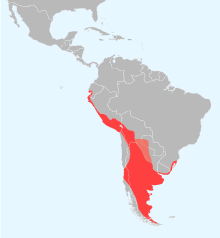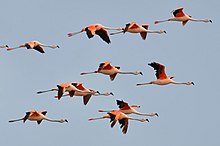Chilean flamingo
| Chilean flamingo | |
|---|---|

| |
| Chilean flamingo with egg at the Tiergarten in Bernburg, Germany | |
| Scientific classification | |
| Kingdom: | |
| Phylum: | |
| Class: | |
| Order: | |
| Family: | |
| Genus: | |
| Species: | P. chilensis
|
| Binomial name | |
| Phoenicopterus chilensis Molina, 1782
| |

| |
The Chilean flamingo (Phoenicopterus chilensis) is a large species of flamingo at 110–130 cm (43–51 in) closely related to American flamingo and greater flamingo, with which it was sometimes considered conspecific.[2] The species is listed as Near Threatened by the IUCN.
It breeds in South America from Ecuador and Peru to Chile and Argentina and east to Brazil; it has been introduced into Germany and the Netherlands (colony on the border, Zwillbrocker Venn). There was also a small population in Utah and California. Like all flamingos it lays a single chalky white egg on a mud mound.
Description



The plumage is pinker than the slightly larger greater flamingo, but less so than Caribbean flamingo. It can be differentiated from these species by its greyish legs with pink joints (tibio-tarsal articulation), and also by the larger amount of black on the bill (more than half). Young chicks may have no sign of pink coloring whatsoever, but instead remain grey.[3]
Diet
The Chilean flamingo's bill is equipped with comb-like structures that enable it to filter food—mainly algae and plankton—from the water of the coastal mudflats, estuaries, lagoons and salt lakes where it lives.[4]
Breeding
Chilean flamingos live in large flocks in the wild and require crowded conditions to stimulate breeding. During breeding season, males and females display a variety of behaviors to attract mates, including head flagging—swiveling their heads from side-to-side in tandem—and wing salutes, where the wings are repeatedly opened and closed. Males and females cooperate in building a pillar-shaped mud nest, and both incubate the egg laid by the female. Upon birth, the chicks have gray plumage; they don't gain the typical pink adult coloration for two-three years. Both male and female flamingos can produce a nutritious milk-like substance in their crop gland to feed their young.[4]
In captivity
The first flamingo hatched in a European zoo was a Chilean flamingo at Zoo Basel (Switzerland) in 1958.[5]
In 1988, a Chilean flamingo that lived in the Tracy Aviary in Salt Lake City, Utah had mistakenly not received his routine wing clipping. The flamingo escaped,[6] and became a local legend in the Greater Salt Lake area known as 'Pink Floyd the Flamingo'. Pink Floyd came to Utah in the winters to eat the brine shrimp that lived in the Great Salt Lake and flew north to Idaho and Montana in the spring and summer. Pink Floyd became a popular tourist attraction and local icon until his disappearance and presumed death[7] after he flew north to Idaho one spring in 2005 and was never heard from again.
See also
References
- ^ Template:IUCN
- ^ Knox A.G., Collinson M., Helbig A.G., Parkin D.P., and Sangster G. (2002). Taxonomic recommendations for British birds. Ibis 144:707-710.
- ^ "Photo". Zoo View. XXXVII (4). Los Angeles Zoo and Botanical Gardens: 1, back cover. 2004.
- ^ a b "Chilean Flamingo Fact Sheet, Lincoln Park Zoo"
- ^ "Zoo celebrates 50 years of flamingo breeding and science". Basler Zeitung. 13 August 2008. Retrieved 21 March 2010.
- ^ "Utah's Wild Chilean Flamingo, Pink Floyd!"
- ^ "Feeling Blue About Pink Floyd". Deseret News. 26 March 2007.
External links
- Chilean Flamingo from the IUCN/Wetlands International Flamingo Specialist Group
- Flamingo Resource Centre - a collection of resources and information related to flamingos
- Chilean Flamingo (Phoenicopterus chilensis) videos and photos at the Internet Bird Collection

